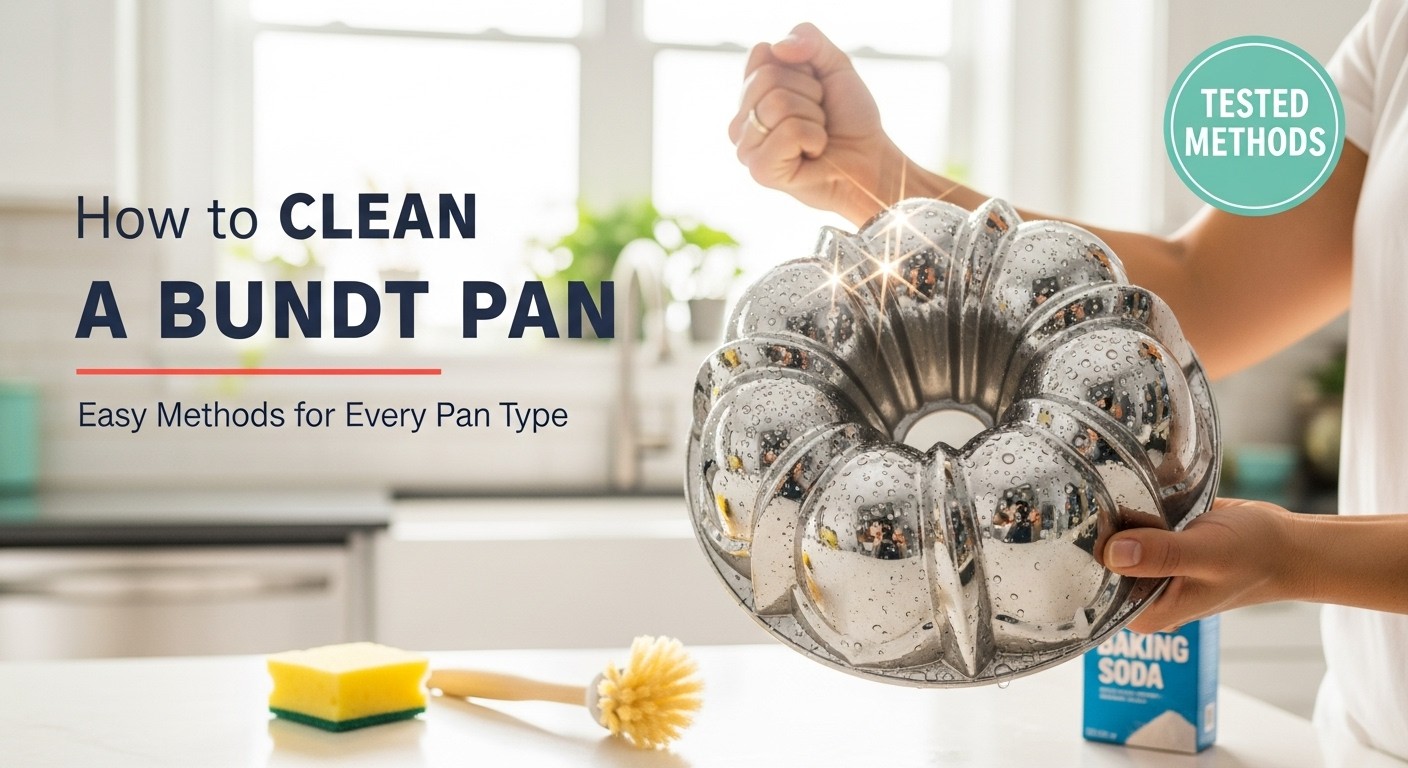
I'll admit it—the first time I baked a gorgeous chocolate bundt cake, I was so proud of myself. The cake turned out beautifully, my family devoured it, and I felt like a baking champion. Then I looked at my bundt pan sitting in the sink, covered in baked-on batter and stubborn grease, and reality hit me hard. Learning how to clean a bundt pan properly has been one of those kitchen skills I wish someone had taught me from the start. After years of trial and error with different types of bundt pans, I've finally figured out what actually works.
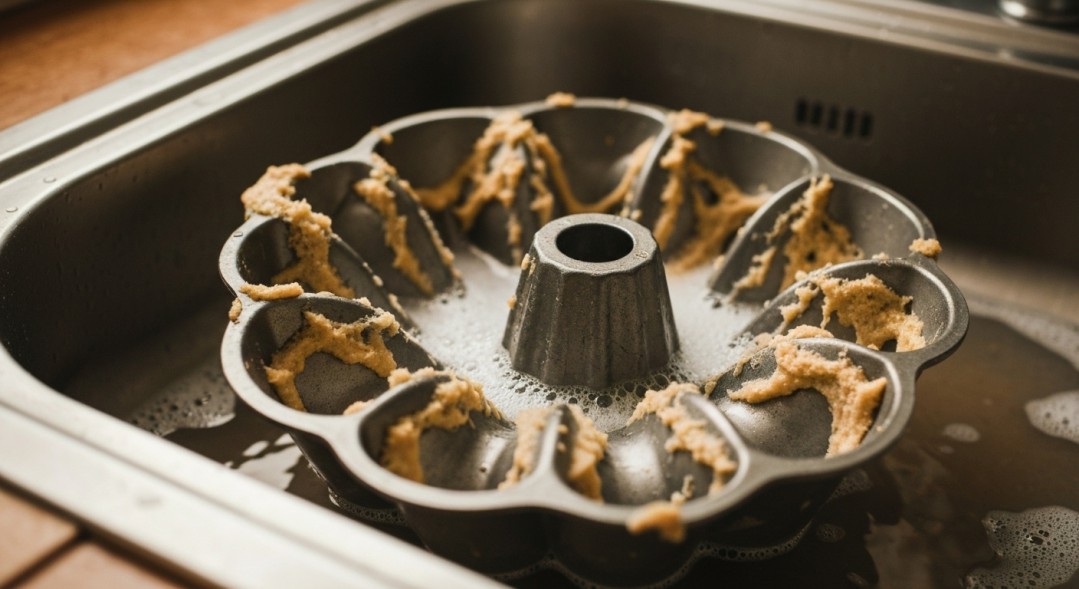
Why Cleaning a Bundt Pan Can Be So Tricky
Let's be honest—bundt pans are gorgeous but they're also a pain to clean. All those intricate grooves, ridges, and decorative patterns that make your cakes look like works of art? They're also perfect little traps for cake residue, grease, and burnt bits. I've spent way too many evenings hunched over my sink, trying to dig cake crumbs out of tiny crevices with a butter knife (not my proudest moments).
The material of your pan matters too. I've worked with several types over the years, and each one has its quirks. My trusty Nordic Ware bundt pan cleans differently than my newer silicone one, and don't even get me started on the vintage metal bundt cake pan I inherited from my grandmother.
The Golden Rule: Clean It Right Away
Here's the thing I learned the hard way—timing is everything when you're dealing with how to clean a bundt pan. I used to let my pan sit overnight because I was too tired after baking and entertaining. Big mistake. When cake batter dries and hardens in those grooves, it becomes cement-like. Now I make it a point to soak my pan as soon as it's cool enough to handle.
Fill your sink with hot water and add a generous squirt of dish soap while the pan is still slightly warm (but not hot—you don't want to warp it). Let it soak for at least 15-20 minutes. This simple step has saved me countless hours of scrubbing and has probably saved my pans from the damage of aggressive scrubbing too.
How to Clean Non-Stick Bundt Pans
Most modern bundt pans, including my beloved Pampered Chef bundt pan, have non-stick coatings. These are honestly the easiest to clean if you treat them gently. After soaking, I use a soft sponge or a non-abrasive scrubbing pad with warm soapy water. The key word here is "gentle." Never use steel wool, metal scrubbers, or harsh abrasive cleaners on non-stick surfaces—you'll scratch the coating and ruin the pan's ability to release cakes cleanly.
For stubborn spots in the decorative grooves, I've found that an old soft-bristled toothbrush works wonders. I keep one specifically for kitchen cleaning. Just work the bristles gently into the grooves with some dish soap, and most residue comes right off. If you're dealing with particularly stubborn bits, make a paste with baking soda and a little water, apply it to the problem areas, and let it sit for 10 minutes before scrubbing.
To clean a Pampered Chef bundt pan or similar non-stick pans, always hand wash them instead of tossing them in the dishwasher. I know the dishwasher seems convenient, but the harsh detergents and high heat can gradually break down that non-stick coating.
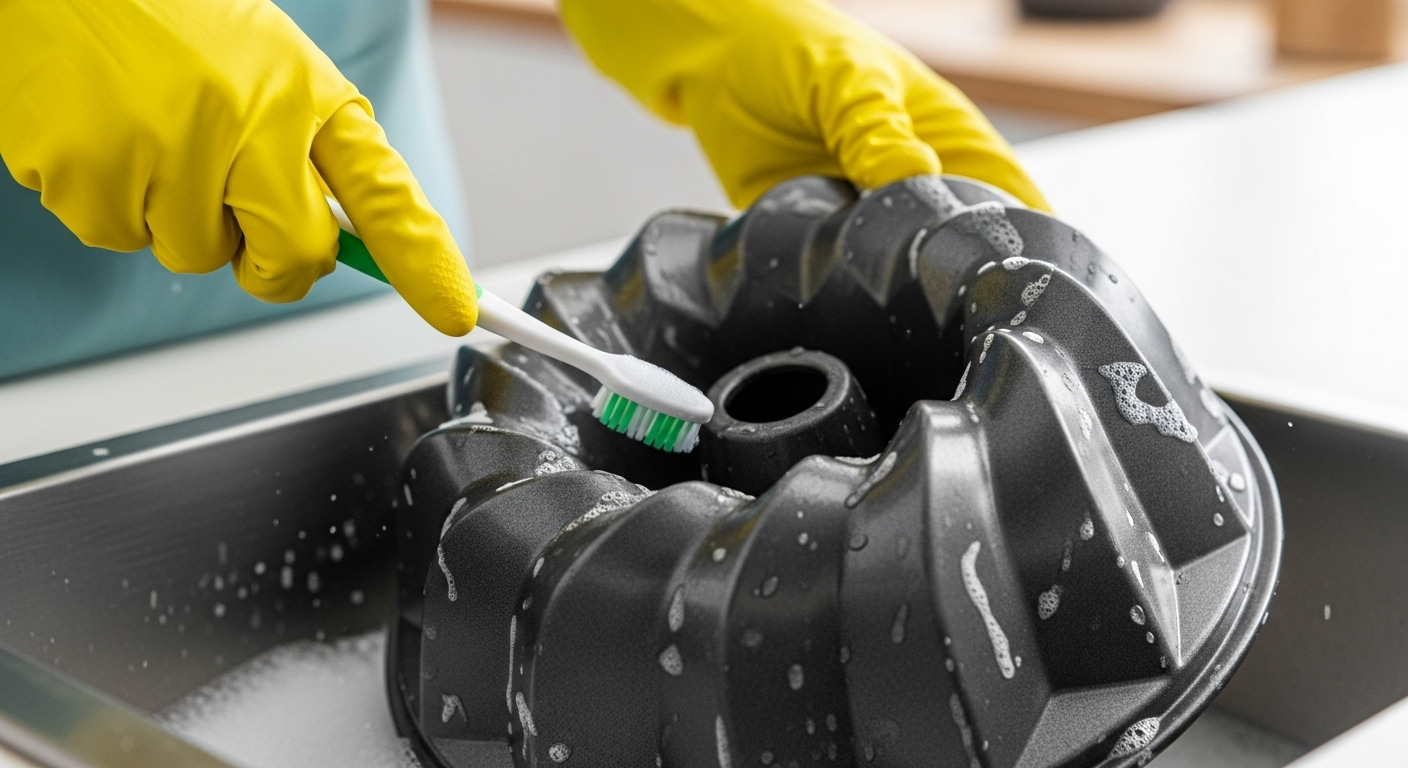
How to Clean Aluminum Bundt Pans
Aluminum pans are lightweight and conduct heat beautifully, but they require a slightly different approach. To clean an aluminum bundt pan, you want to avoid anything too alkaline (like some heavy-duty degreasers) because it can cause discoloration. I learned this when I tried to clean my aluminum pan with a powerful cleaner and ended up with dark spots all over it.
Stick with regular dish soap and warm water for routine cleaning. If your aluminum pan has developed some discoloration or darkening over time, don't panic—it's totally normal and won't affect your baking. However, if it bothers you aesthetically, here's a trick that worked for me: fill the pan with water, add a few tablespoons of white vinegar or lemon juice, and bring it to a simmer on the stove for about 10 minutes. Let it cool, then wash normally. The acid helps restore some of the original shine.
For stuck-on residue when you need to clean an aluminum bundt pan thoroughly, the baking soda paste method I mentioned earlier works great here too. Just be patient and let the paste do the work rather than scrubbing aggressively.
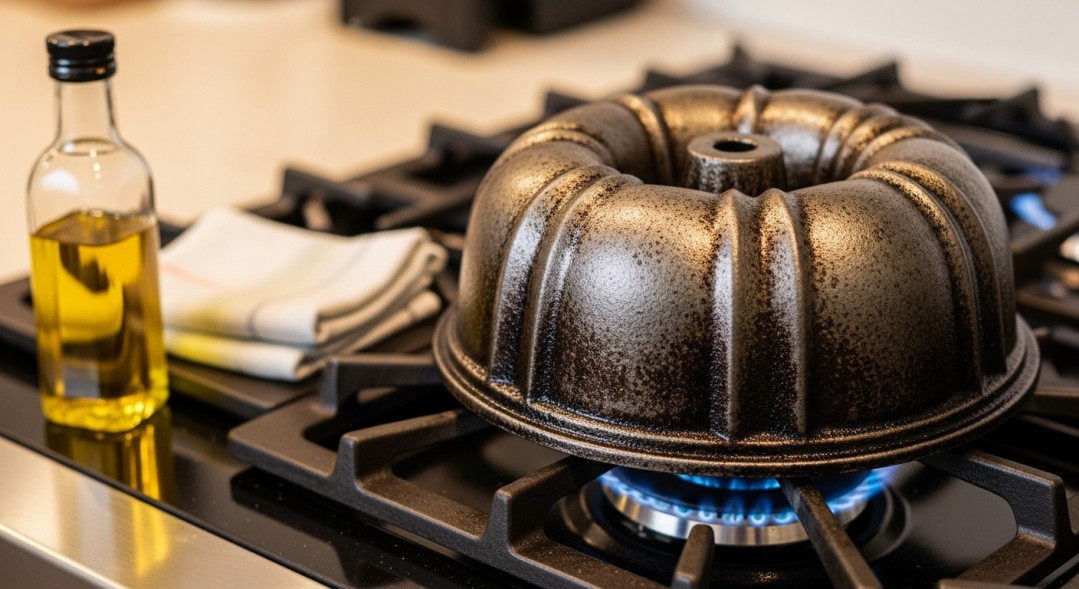
How to Clean a Cast Iron Bundt Pan
Cast iron bundt pans are beautiful, heavy, and absolutely fantastic for creating evenly baked cakes with amazing crusts. But cleaning them requires special care because you're maintaining that precious seasoning layer. When I first got my cast iron bundt pan, I made the mistake of treating it like my other pans—wrong move.
To clean a cast iron bundt pan, never soak it in water for long periods and definitely avoid dish soap if possible (though a tiny amount won't ruin it if the pan is well-seasoned). Instead, I clean mine while it's still slightly warm. I use hot water and a stiff brush or a chainmail scrubber specifically made for cast iron. For really stubborn spots, coarse salt works as a gentle abrasive—just sprinkle it in the grooves and scrub with a damp cloth.
The most important step? Dry it completely and immediately. I put mine on a warm burner for a minute or two to evaporate any remaining moisture. Then I apply a very thin layer of cooking oil all over, including in all those grooves, to maintain the seasoning. This prevents rust and keeps the pan naturally non-stick.
How to Clean a Silicone Bundt Pan
Silicone bundt pans are a game-changer for easy cake release, but they have their own cleaning challenges. Mine always seemed to retain a greasy film no matter how much I washed it. To clean a silicone bundt pan effectively, I discovered you need hotter water than you'd think and sometimes a degreasing boost.
After each use, I wash my silicone pan in the hottest water I can stand with plenty of dish soap. For that persistent greasy feeling, I make a paste with baking soda and a drop of dish soap, then scrub the entire surface. Silicone is durable, so you can be a bit more aggressive than with non-stick coatings.
One trick that really helps: occasionally, I put my silicone bundt pan in the oven at 350°F for about 20 minutes (empty, of course). This helps burn off any residual oils that regular washing doesn't remove. Just make sure your kitchen is well-ventilated because it can smell a bit. The good news? Silicone pans are dishwasher-safe, so if hand washing isn't cutting it, the dishwasher can be your friend.
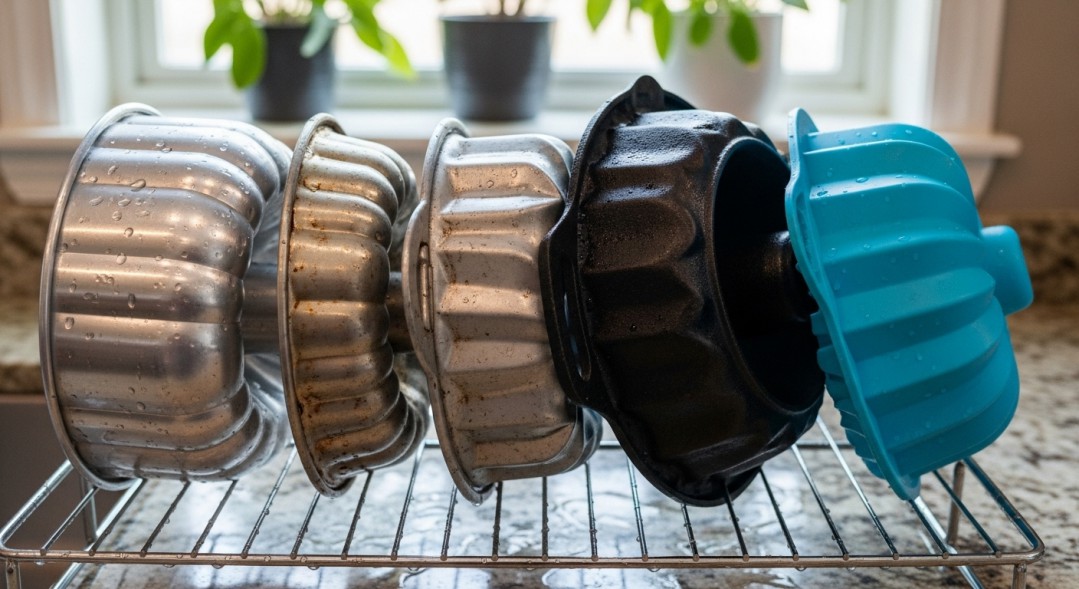
Special Care for Vintage and Nordic Ware Pans
Vintage metal bundt cake pans have a special place in my heart. My grandmother's pan has made countless birthday cakes over the decades. To clean a vintage metal bundt cake pan, I'm extra gentle because these beauties often don't have modern non-stick coatings. I treat them similarly to aluminum pans—warm soapy water, soft sponge, and lots of patience.
Nordic Ware is practically synonymous with bundt pans, and I own two. To clean a Nordic Ware bundt pan, I follow the manufacturer's recommendations: hand wash with warm soapy water and avoid harsh abrasives. These pans are built to last generations if you care for them properly. I always dry mine thoroughly with a soft towel and sometimes let them air dry completely before storing to prevent any water spots or potential rust.
Prevention Is Easier Than Cure
After all my cleaning struggles, I've realized that preventing stuck-on messes is half the battle when it comes to how to clean a bundt pan. Now I'm obsessive about proper greasing before baking. I use a pastry brush to apply softened butter or shortening (not cooking spray—it can leave a sticky residue) to every single groove and corner, then dust with flour. Some bakers swear by the Baker's Joy spray, and I admit it works well too.
I also let my cakes cool in the pan for exactly the time the recipe recommends—usually 10-15 minutes—then turn them out. Too soon and the cake falls apart; too long and it sticks. Getting this timing right means less cake stuck in the pan and less cleaning hassle for me.
When All Else Fails
Sometimes, despite your best efforts, you'll face a seemingly impossible cleaning situation. I've been there—staring at a pan that looks beyond hope. Before you give up, try this method that's saved my pans more than once: fill the pan with very hot water, add a dishwasher tablet or a few tablespoons of oxygen bleach powder (like OxiClean), and let it soak for several hours or overnight. The enzymes work to break down baked-on residue. After soaking, most of the stuck-on mess should wipe away easily.
Learning how to clean a bundt pan properly has made me enjoy baking with these beautiful pans so much more. There's no more dread about the cleanup, and my pans are in better condition than ever. Whether you're working with a high-end Nordic Ware, a budget-friendly non-stick pan, or a treasured vintage piece, taking a few extra minutes to clean it properly means it'll serve you well for years to come. Trust me, your future baking self will thank you.
Leave a Reply